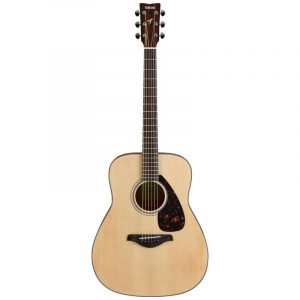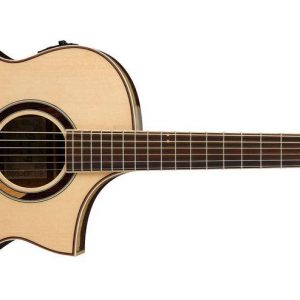Epiphone Lil’ Tex
$181.99
Experience the soulful sound of the Epiphone Lil’ Tex – the perfect guitar for beginners and experienced musicians alike.
Compare
Description
The Epiphone Lil’ Tex is an affordable acoustic guitar that provides a classic, vintage-style sound. It is inspired by the legendary Gibson J-200, which has been played by many famous musicians, such as Elvis Presley and Bob Dylan. This model is a smaller version of the J-200, making it more comfortable for smaller players or those who prefer a more compact instrument.
The Lil’ Tex features a Solid Sitka Spruce top and mahogany back and sides, providing a balanced and warm tone. The SlimTaper profile neck is also made of mahogany and has a rosewood fingerboard with 20 medium frets. The guitar has a natural finish with a tortoiseshell pickguard, giving it a classic and stylish look.
Another feature that makes the Lil’ Tex stand out is its Fishman Sonicore pickup system, which allows the guitar to be amplified for live performances or recording sessions. The system also includes a Sonitone preamp with volume and tone controls, making it easy to adjust the sound to suit your preference.
Overall, the Epiphone Lil’ Tex is a versatile and reliable instrument for both beginners and experienced players. Its design and sound quality make it a great choice for country, folk, and acoustic-rock styles.
Epiphone Lil’ Tex properties
| Product name |
Lil’ Tex |
| Brand |
Epiphone |
| Type |
String Instruments |
| String Instruments |
Acoustic Guitar |
| Number of Strings |
6 pcs |
| Handedness |
Right-handed |
| Number of Frets |
19 |
| Cutaway |
No Cutaway |
| Size |
4/4 |
| Pickguard |
Yes |
| Wood Type (front) |
Spruce |
| Wood Type (back) |
Sapele |
| Wood Type (body sides) |
Sapele |
| Wood Type (neck) |
Mahogany |
| Colour |
Fireburst/Colourburst |
Frequently Asked Questions:
How does the onboard preamp system of the Epiphone Lil' Tex acoustic guitar enhance its overall tone and versatility for stage performances?
The onboard preamp system of the Epiphone Lil' Tex acoustic guitar significantly enhances its overall tone and versatility for stage performances. This system includes a built-in preamplifier, equalizer, and volume control that allow for fine-tuning of the instrument's acoustics to suit various performance settings. The preamp ensures a clear and balanced sound that can cut through loud band mixes or amplified PA systems, making it ideal for live stage performances where acoustic instruments may otherwise get lost in the mix. Additionally, the equalizer allows for adjustment of bass, midrange, and treble frequencies to suit different playing styles and performance venues. Overall, this preamp system adds a level of flexibility and versatility that makes the Epiphone Lil' Tex an excellent choice for musicians who want to take their acoustic guitar performances to the stage.
How does the onboard piezo pickup system in the Epiphone Lil' Tex contribute to its versatile tone capabilities?
The onboard piezo pickup system in the Epiphone Lil' Tex allows for versatile tone capabilities by providing both acoustic and electric sounds. This innovative feature allows players to switch seamlessly between a rich, natural acoustic sound and a bright, crisp electric tone with the push of a button. Whether playing traditional blues or experimenting with more modern genres, the piezo pickup system in the Epiphone Lil' Tex provides the flexibility needed for a wide range of musical styles.
How does the proprietary '60s style humbucker pickup on the Epiphone Lil' Tex differ from traditional humbuckers, and how does it contribute to its unique tone?
The proprietary '60s style humbucker pickup on the Epiphone Lil' Tex is designed to deliver a unique tonal character that sets it apart from traditional humbuckers. While traditional humbuckers typically produce a rich, full-bodied sound with plenty of low-end power and midrange growl, the '60s style pickups on the Lil' Tex are brighter and more articulate in their response. The brightness is achieved through a higher output level than traditional humbuckers, which results in a greater emphasis on high frequencies. This clarity allows for greater note definition and a clearer separation between notes, especially at higher gain levels. The midrange response is also slightly scooped, which helps to reduce muddy or boxy tones that can occur with some traditional humbuckers, while still retaining plenty of warmth and depth in the sound. Overall, the unique tonal characteristics of these pickups contribute to a bright, clear, and articulate sound that is perfect for players who prefer a more modern or high-gain style of playing. Whether you're looking to achieve searing leads, tight rhythm work, or anything in between, the Epiphone Lil' Tex with its proprietary '60s style humbuckers is an excellent choice for players who demand exceptional tonal clarity and definition from their instruments.
How do you adjust the bridge on a vintage Epiphone Lil' Tex acoustic guitar to achieve proper intonation and prevent buzzing or rattling at the low E string?
1. Understand the relationship between the bridge and nut:** The bridge and nut are connected by the strings, which means any adjustment made to one affects the other. Proper intonation requires that the bridge be in line with the nut. Remove the old bridge pins or screws:** Before you can make adjustments, you need access to the bridge. Remove the screws or pull out the bridge pins gently, taking care not to strip the screw threads or break any of the bridge pin holes in the body of your guitar. Inspect and clean the area around the bridge:** Dirt, grime, and old glue can interfere with the adjustment process. Clean this area thoroughly, paying special attention to the bridge itself and the surrounding nut slot. Lift the bridge slightly:** Gently lift the bridge using a screwdriver or a small chisel, taking care not to apply too much pressure that could damage the guitar's body. You might need to remove the old bridge screws first if they're stuck due to old glue. Adjust the bridge height and angle:** Once you have access, adjust the bridge to the correct height and angle. The ideal setup for a vintage acoustic is slightly closer to the fretboard than a modern guitar, but still high enough to allow proper string clearance over the fretboard. Check intonation at the 12th fret:** Play the low E string at the 12th fret with your finger on the nut and then lift your finger off the fretboard while keeping pressure on the string at the 12th fret. If the note sounds sharp, lower the bridge slightly; if it's flat, raise it. Check for buzzing or rattling:** Play the low E string open to check for any buzzing or rattling. Adjust the bridge height and angle until the sound is clear and smooth without any unwanted overtones. Reinstall the bridge pins or screws:** Once you've achieved proper intonation, carefully reinstall the screws or push in new bridge pins. Make sure they're seated properly and not too loose to prevent future adjustments affecting your setup. Play and adjust:** After reassembling, play the guitar thoroughly and make any further adjustments as needed. The goal is a clear, smooth sound without buzzing or rattling at the low E string. Consider professional help if necessary:** If you're not comfortable with this process or if your adjustments don't seem to be working as expected, it's always a good idea to consult a professional luthier for further assistance. They can provide personalized advice and adjustments tailored specifically to your guitar. Remember, achieving proper intonation on an old guitar can be a bit of trial and error due to the wear and tear over the years. Be patient, and don't hesitate to seek help if you're unsure about any step in the process.
Before you buy Epiphone Lil’ Tex










Juliana –
I couldn’t help but smile at how easy it was to play. This little guitar packs a punch in terms of sound quality, despite its small size. And the best part? It’s helping save the planet one chord at a time thanks to its impressive power efficiency.
Now, I know what you’re thinking – Who cares about power efficiency in a guitar? Well, my dear reader, let me tell you that it’s not just about being eco-friendly (although that’s definitely a plus). The Epiphone Lil’ Tex is equipped with an advanced electronics system that allows for clear and crisp sound output even at lower volumes. That means you can practice late at night without disturbing your neighbors, or perform in intimate settings without the need for excessive amplification.
But enough about that – let’s talk about my recent visit to Super 8 located at 72 S 72nd St, Omaha, NE 68114, United States. I was in town for a music festival and decided to swing by the hotel to check out their guitar rental options. To my surprise, they had a few Epiphone Lil’ Texes available at a very reasonable price. I snatched one up and spent the rest of the day jamming with some local musicians. It was an unforgettable experience, and I have Super 8 to thank for it.
As for tips and tricks for those interested in buying an acoustic guitar, here are a few:
1. Try before you buy – this is especially important if you’re new to playing or unsure about your preferred style. Different guitars have different sounds and feels, so it’s worth taking the time to test out a few options.
2. Consider your budget – acoustic guitars can range from a few hundred dollars to several thousand. Decide how much you’re willing to spend upfront and stick to that limit.
3. Look for quality materials – a guitar’s sound is largely determined by the type of wood it’s made out of. Sapele, like what you’ll find in the Epiphone Lil’ Tex, is a popular choice due to its warm and resonant tone.
4. Pay attention to playability – this refers to how easy it is to move your fingers around the fretboard and form chords. A guitar with good playability will be more comfortable to play, especially for beginners.
5. Don’t forget about accessories – a sturdy case or gig bag is essential for protecting your guitar during transport, while a tuner or metronome can help you stay in tune and improve your timing.
In conclusion, the Epiphone Lil’ Tex is more than just a small acoustic guitar – it’s a sustainable and versatile instrument that delights both beginners and experienced musicians alike. And with its romantic wood type-back of Sapele, it’s sure to bring intimacy and connection into your music making journey. So why wait? Head down to Super 8 and try one out for yourself today!
P.S. In case you’re wondering about the news I mentioned earlier, Genuine Parts (GPC) is set to report earnings tomorrow with analysts predicting a revenue growth of 2.1% and $2.59 EPS. However, it’s worth keeping in mind that the company has missed revenue targets in the past, so investors should exercise caution when interpreting the results.